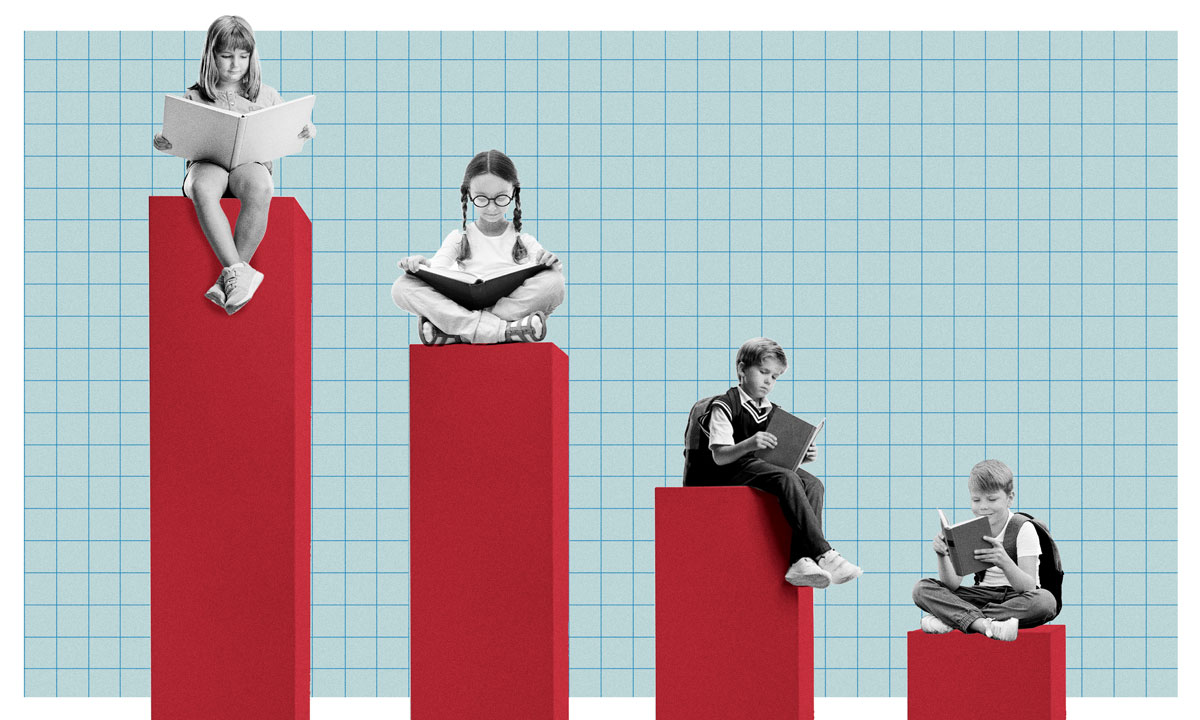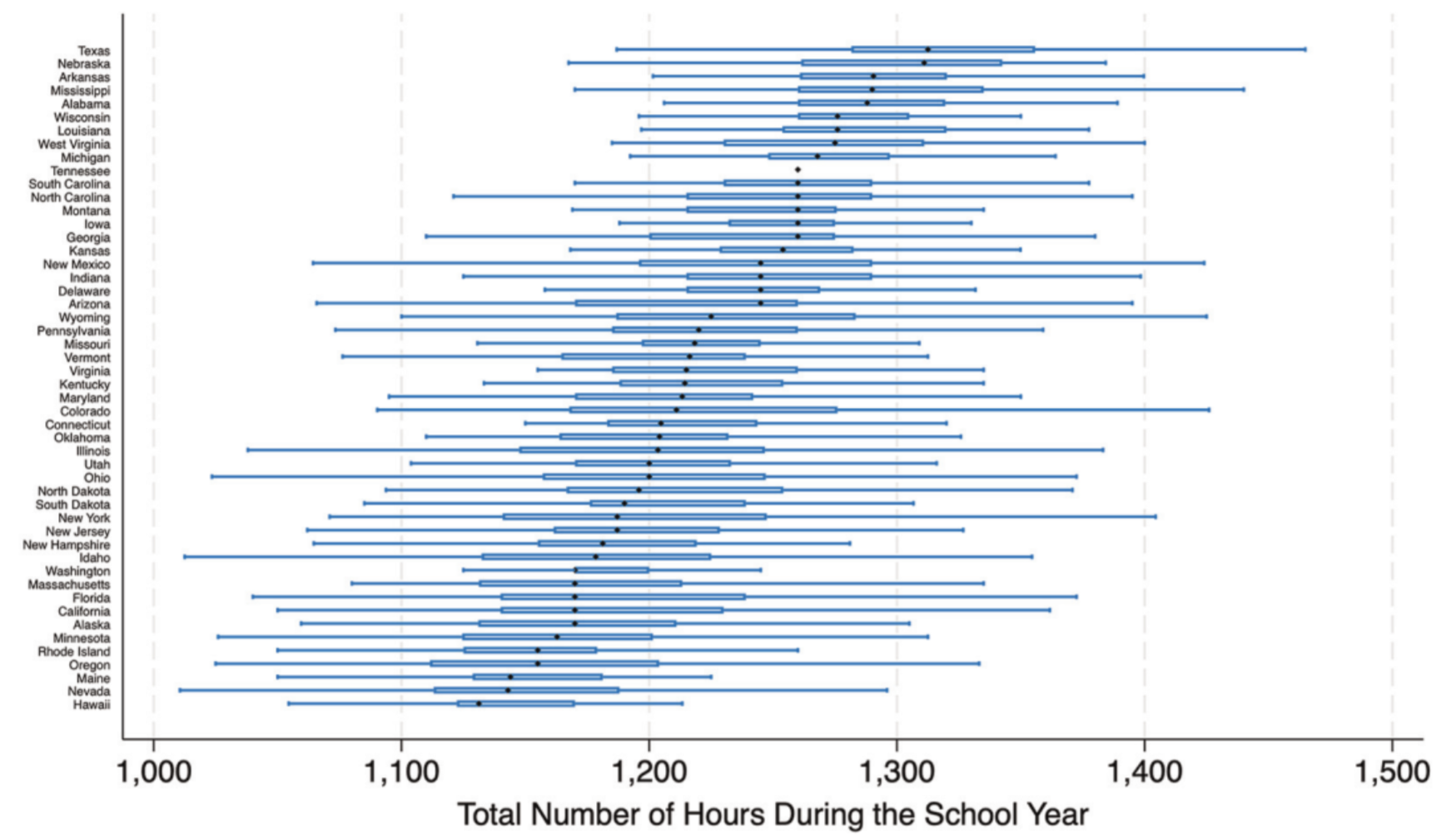Class Time Roulette: Kids Receive Up to Two Years More School Depending on Where They Live
Texas and Nebraska mandate that kids get the most instructional time of any state. Hawaii and Nevada require the least.

Get stories like these delivered straight to your inbox. Sign up for The 74 Newsletter
Depending on where they grow up, some American students receive considerably less schooling every year than their peers in other areas, according to newly published research. Worse still, when accounting for student absences, suspensions, and classroom interruptions, much of the time intended for instruction in some districts is simply lost.
Seemingly minute differences in the length of a school day or year, whether stemming from state laws or local rules governing school districts, eventually grow into colossal gaps in learning opportunities. Over the course of their K–12 careers, the authors estimate, children living in jurisdictions requiring the most time in school benefit from over two years more education than those living in areas that require the least.
“It’s hard for me to understand why some students should have access to a 180-day school year, and others in a district down the road get two weeks less instruction,” said co-author Matthew Kraft, an economics professor at Brown University. “Why would we want that inequity baked into our system?”
The paper, published Monday in the American Education Research Journal, relies primarily on figures collected before the emergence of COVID-19. But its resonance will inevitably be heightened by the post-pandemic crisis of chronic absenteeism, during which one-quarter of students nationwide missed at least 10 percent of the school year in 2023–24. At the same time, owing both to budgetary challenges and popular choice, a growing number of school districts are shifting to a four-day week.
The pronounced geographic divergences in access to instructional time are largely the product of state laws. While 37 states mandate a minimum number of days in the academic year, their requirements range from 160 days in Colorado to 186 days in Kansas; among the 37 states that set a floor for instructional hours in a year, Arizona is at the bottom with 720, while Texas is at the top with 1,260.
It's hard for me to understand why some students should have access to a 180-day school year, and others in a district down the road get two weeks less instruction.
Matt Kraft, Brown University
In other words, while the average American K–12 school is in session for 179 days a year, for just under seven hours each day, local variation is much wider.
Drawing on data from the U.S. Census’s nationally representative National Teacher and Principal Survey, the study finds that schools at the 90th percentile of instructional time nationwide offer 1.17 more hours of school each day than those at the 10th percentile. Throughout the school year, those approximately 70 minutes per day accumulate into a disparity of 196 hours of teaching, or about five and a half weeks of school annually.
Some school districts set their own requirements for time in school higher than those set by their respective states. But at the median, schools in the five states that set highest minimum amount of instructional time (Texas, Nebraska, Arkansas, Mississippi, and Alabama) are open for 133 hours more per year than those in the five states with the lowest minimums (Hawaii, Nevada, Maine, Oregon, and Rhode Island). Cumulatively, students in the first five states will receive 1.4 more years of schooling from kindergarten through the twelfth grade.
Even acknowledging those differences, some kids are actually exposed to less instructional time than their state or district stipulates. As a case study, Kraft and co-author Sarah Novicoff examine the Providence Public School District in Rhode Island, which offers 1,174 annual hours of instructional time for elementary schools and 1,215 hours for secondary schools.
After using state data to tally students’ excused and unexcused absences, teacher absences, tardies, suspensions, and a host of outside interruptions — Kraft has previously found that intercom announcements, staff pullouts, and principal “fly-bys” can disrupt the typical classroom as many as 2,000 times each year — the authors calculate that a typical Providence elementary schooler misses 16 percent of their intended instructional time. The average high schooler misses as much as 25 percent.
Novicoff, a former middle school teacher now pursuing a doctorate at Stanford, said that school staff and administrators should aim to harvest low-hanging fruit during the school day by doing everything in their power to minimize in-class disruptions.
“They can say, ‘If I want to pull a kid from that classroom, I’m going to shoot their teacher a chat message instead of banging on their door,’” she suggested. “The difference there is the degree to which students notice and are disrupted.”
Effects on achievement
But while some educators work to maximize the time available to them, others have happily embraced a shorter school week over the last few years.
Between 2019 and 2023, the number of school districts operating on four-day weeks has climbed from about 662 to almost 900, according to a count kept by Paul N. Thompson, an economics professor at Oregon State University. The switch has been especially popular in more rural districts that tend to face greater transportation challenges and welcome a simplified schedule.
But Thompson’s research shows that districts in Oregon that made the change have seen substantial losses in achievement. Although the schools compensated for the missing day by lengthening the four remaining, students still lost out on several hours of school each week. Notably, the learning losses at those schools grew the longer they stayed on a four-day week, suggesting that the effects were compounding as students lost more instructional time.

Recently, Thompson undertook a new study of four-day weeks around the United States, again concluding that they were associated with significant declines on test scores. The academic slippage was greatest in schools that lost more instructional time, as well as those in less rural settings.
We have good evidence that summer school can positively impact student achievement, particularly in math.
Emily Morton, CALDER
Emily Morton, a co-author of that study and a researcher at the Center for Analysis of Longitudinal Data in Education Research said she thought her findings about the benefits of more instructional time generally dovetailed with those of Kraft and Novicoff. But she recommended that, before changing the law to require more school hours and days, states should heed the example of Providence and find ways to maximize the instructional time already being provided.
“It seems wise and more cost-effective to first focus on recovering time that currently is ‘lost’ during the school day or year (through interruptions, announcements, absences, etc.),” Morton said. “I would also say we have good evidence that summer school can positively impact student achievement, particularly in math.”
Indeed, schools and educators sometimes resist when pushed to remain in session for longer. After New Mexico passed a law last year that significantly lifted the minimum number of annual instructional hours s, the state education department declared that districts had to implement the new rule by offering a 180-day year. In response, over 50 school districts sued.
Kraft suggested that state authorities consider approaches that would allow communities to opt in to longer school years or experiment with ways of increasing instruction.
“We have to be conscientious about the potential unintended consequences of increasing minimums,” he said. “It has to be done in a way that schools and districts feel supported.”
The most important task lying ahead for education leaders is reversing the tide of disengagement and absenteeism that has rocked schools the last four years. Kraft and Novicoff’s data from Providence dates back to 2016, but nationwide attendance plummeted during the era of virtual schooling and has not recovered. It is reasonable to expect that, during the 2023–24 school year, millions of absent students missed tens of millions of classroom hours.
Jennifer Davis, a former official in the U.S. Department of Education and the co-founder of the National Center for Time & Learning, called chronic absenteeism a “huge problem” that schools would have to overcome to keep their students on-track for graduation. Additional resources, including community outreach navigators and alternative learning experiences, might be necessary to rebuild the connections between students and schools, she added.
“Without this,” Davis wrote in an email, “we are going to lose the COVID generation.”
Get stories like these delivered straight to your inbox. Sign up for The 74 Newsletter




